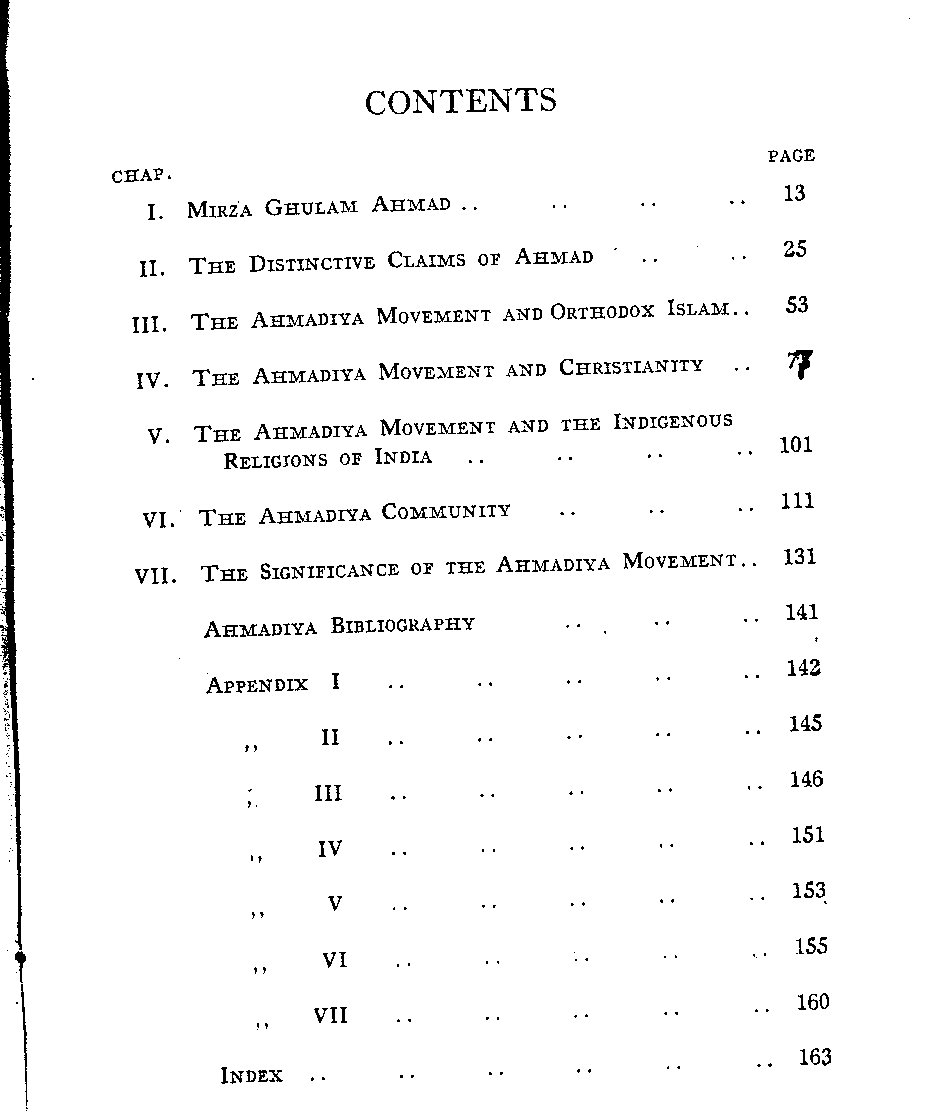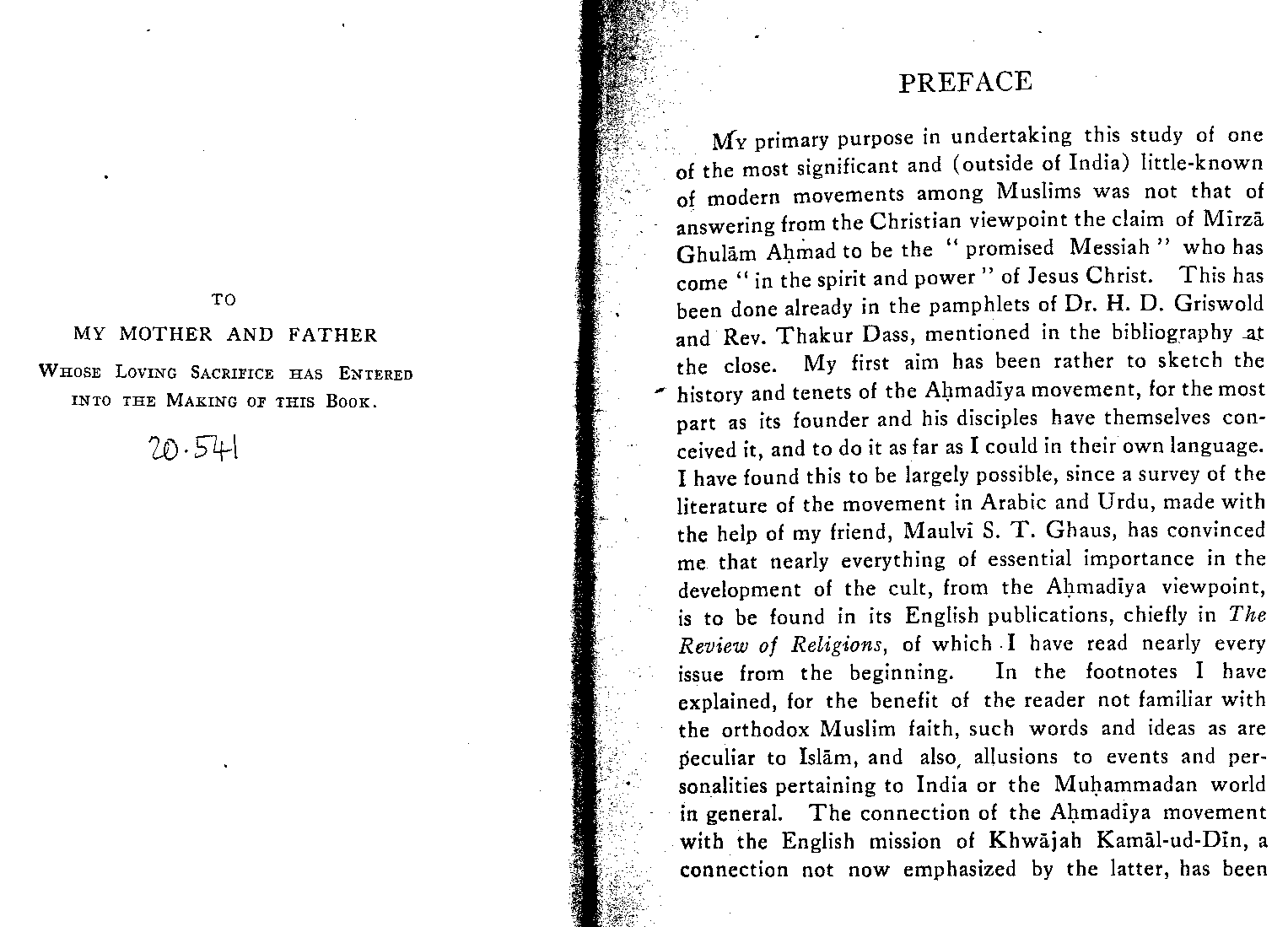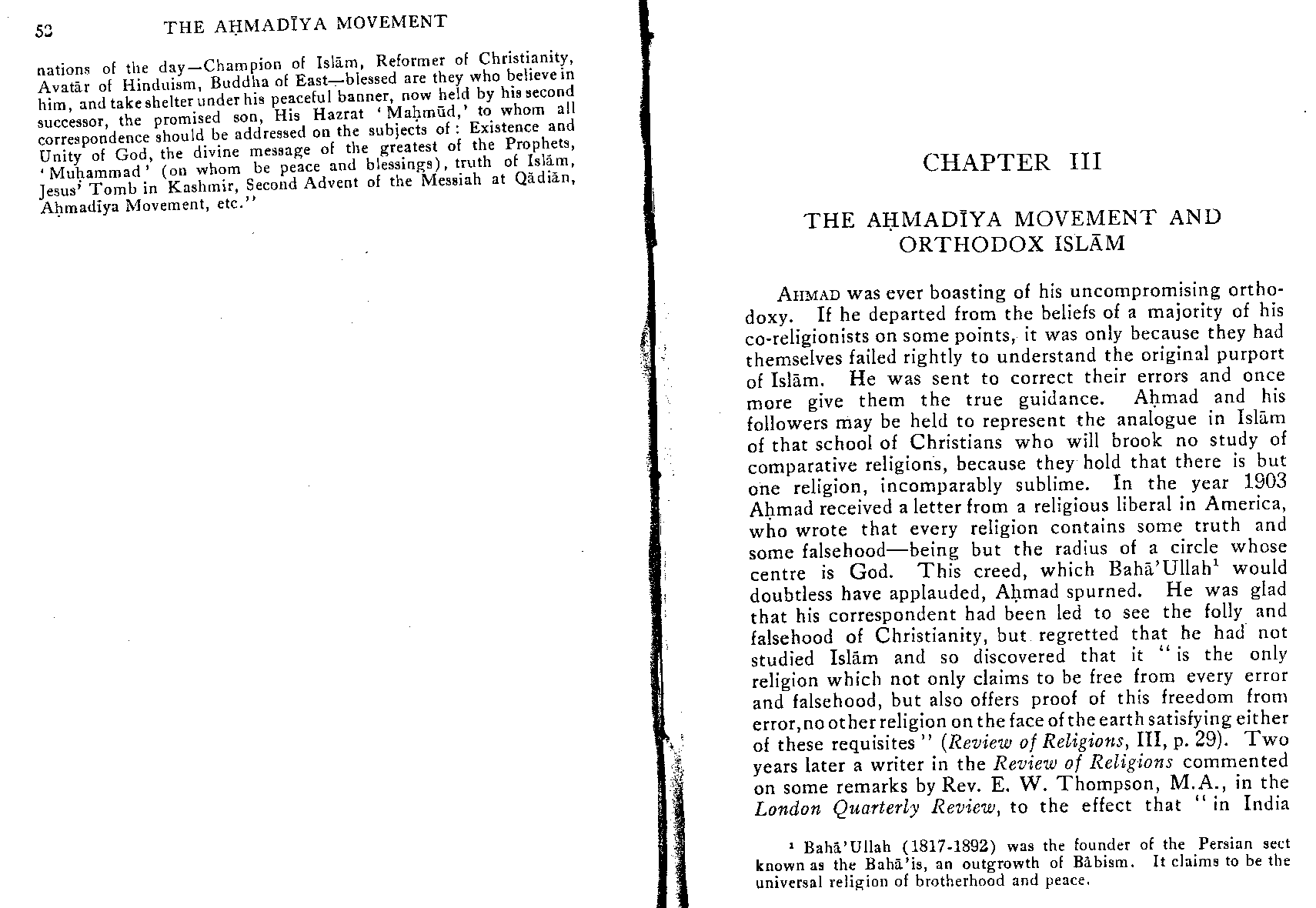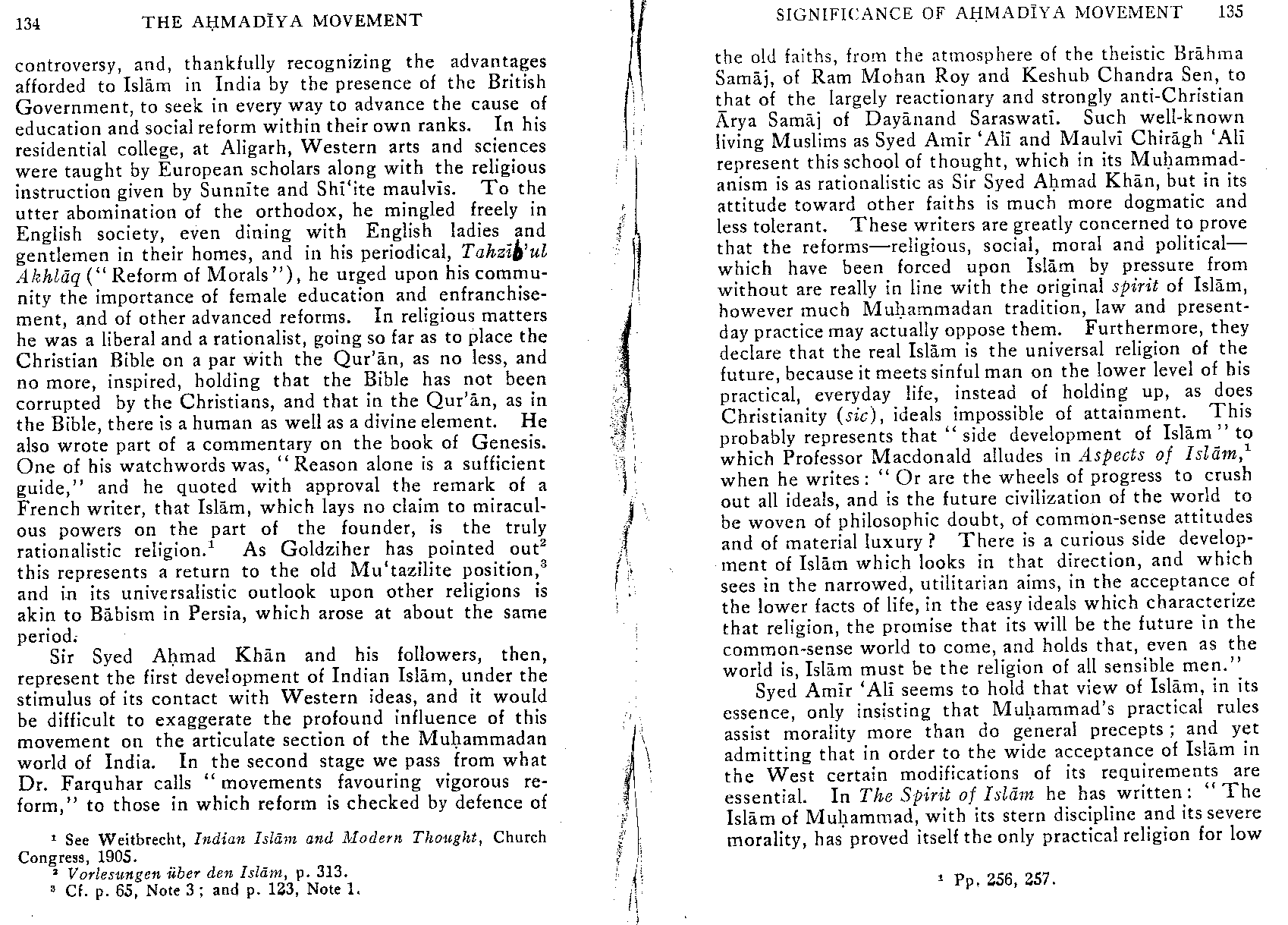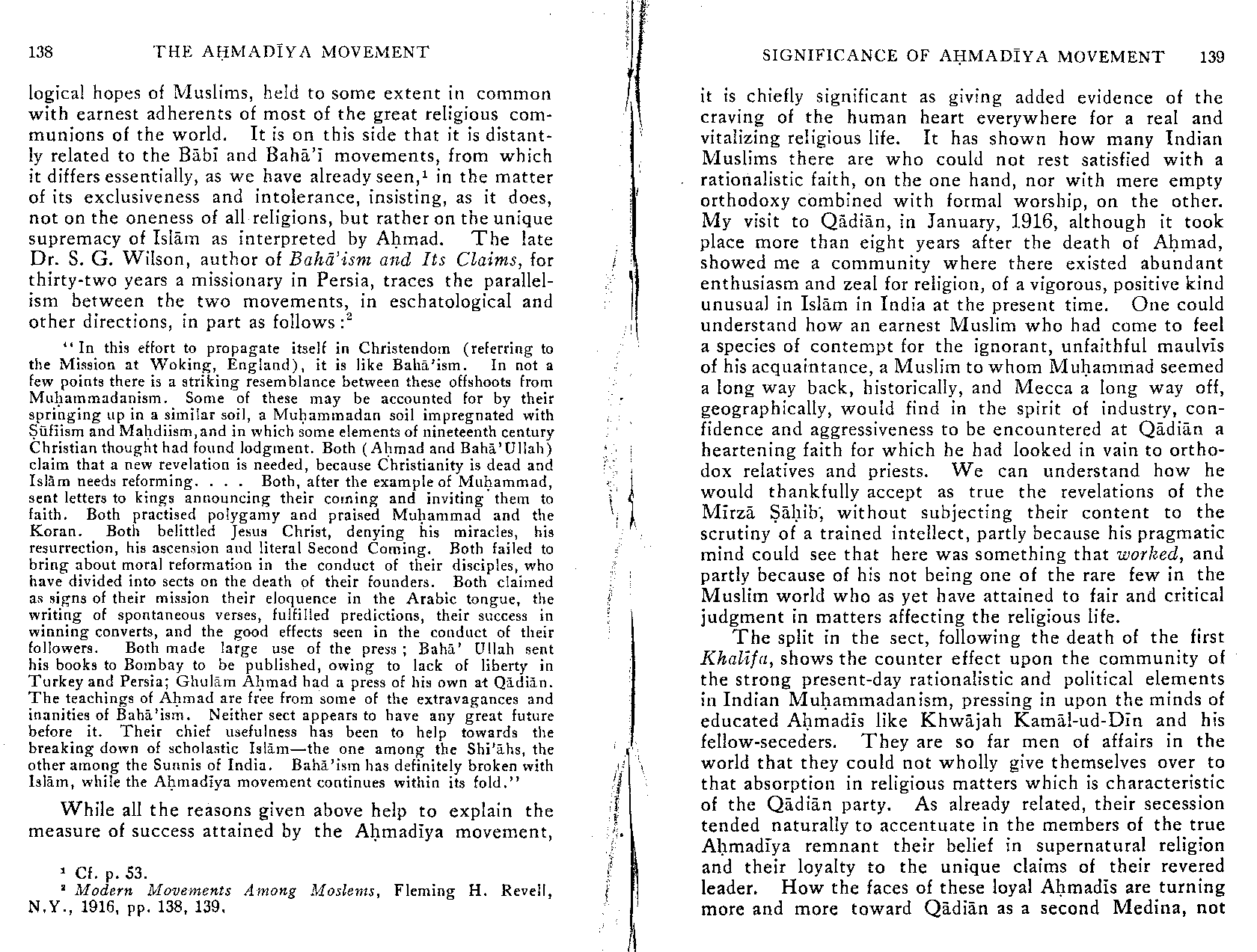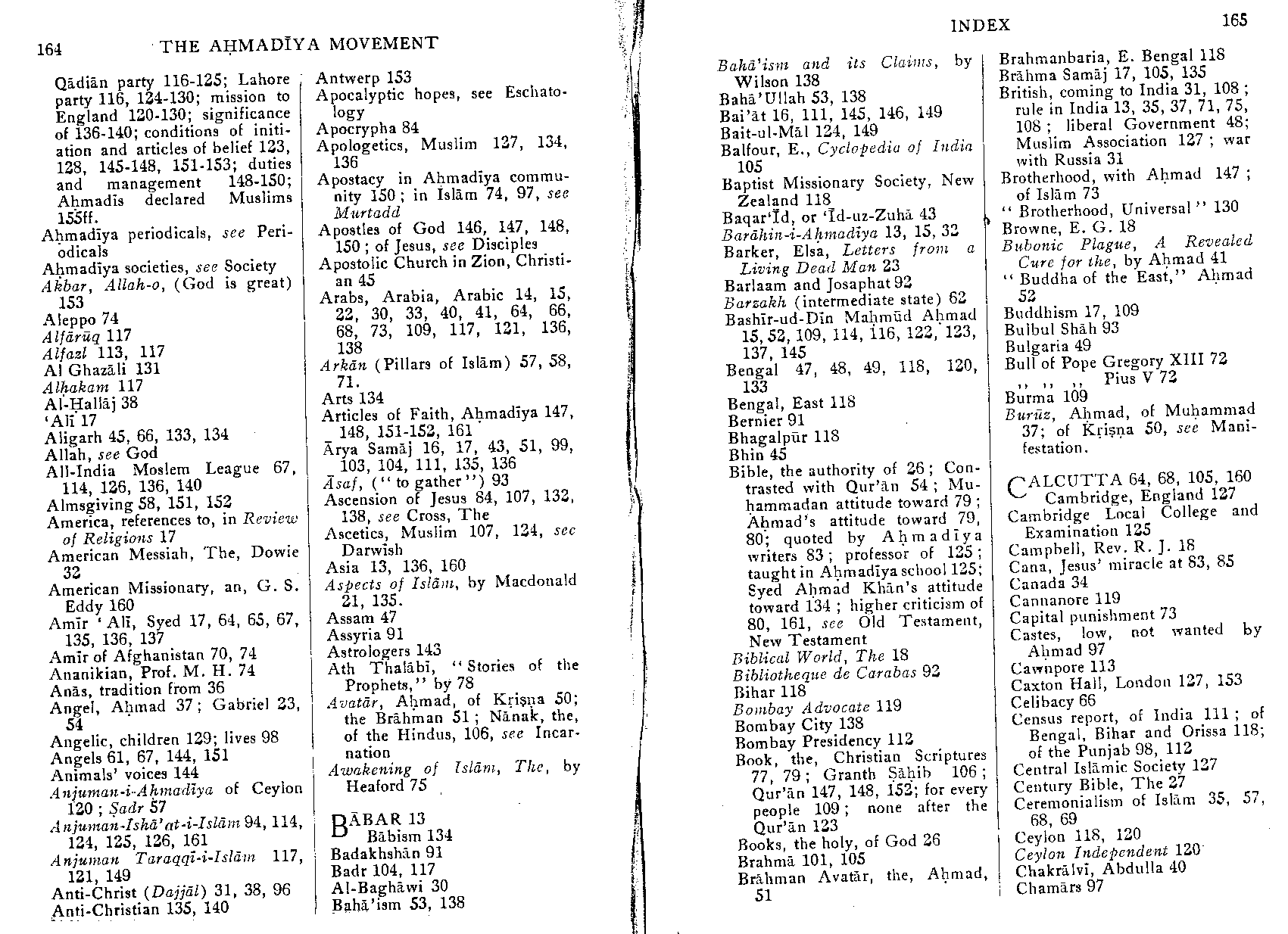
|
|
Abstract: Old commentary on similarities and difference between the Ahmadiya and Bábí-Bahá'í movements. Notes: Author note: Member of the Royal Asiatic Society. This document is also online at scribd.com. |
The Ahmadiya Movement
by H. A. Walter
pages 52-53, 134-135, 138London: Oxford University Press, 1918
1. Text
[page 52]
THE AHMADIYA MOVEMENT
... nations of the day-Champion of Islam, Reformer of Christianity, Avatar
of Hinduism, Buddha of East-blessed are they who believe in him, and take
shelter under his peaceful banner, now held by his second successor, the
promised son, His Hazrat 'Mahmud,' to whom all correspondence should be
addressed on the subjects of: Existence and Unity of God, the divine message of
the greatest of the Prophets, 'Muhammad' (on whom be peace and blessings),
truth of Islam, Jesus' Tomb in Kashmir, Second Advent of the Messiah at Qadian,
Ahmadiya Movement, etc."
[page 53]
CHAPTER III
THE AHMADIYA MOVEMENT AND ORTHODOX ISLAM
Ahmad was ever boasting of his uncompromising orthodoxy. If he
departed from the beliefs of a majority of his coreligionists on some points,
it was only because they had themselves failed rightly to understand the
original purport of Islam. He was sent to correct their errors and once more
give them the true guidance. Ahmad and his followers may be held to represent
the analogue in Islam of that school of Christians who will brook no study of
comparative religions, because they hold that there is but one religion,
incomparably sublime. In the year 1903 Ahmad received a letter from a religious
liberal in America, who wrote that every religion contains some truth and some
falsehood-being but the radius of a circle whose centre is God. This creed,
which Bahá'u'lláh1 would doubtless have applauded, Ahmad spurned. He
was glad that his correspondent had been led to see the folly and falsehood of
Christianity, but regretted that he had not studied Islam and so discovered
that it "is the only religion which not only claims to be free from every error
and falsehood, but also offers proof of this freedom from error, no other
religion on the face of the earth satisfying either of these requisites"
(Review of Religions, III, p. 29). Two years later a writer in the
Review of Religions commented on some remarks by Rev. E. W. Thompson,
M.A., in the London Quarterly Review, to the effect that "in India ...
1 Bahá'u'lláh (1817-1892) was the founder of the Persian sect known as the Bahá'ís, an outgrowth of Babism. It claims to be the universal religion of brotherhood and peace.
[page 134]
THE AHMADIYA MOVEMENT
... controversy, and, thankfully recognizing the advantages afforded to
Islam in India by the presence of the British Government, to seek in every way
to advance the cause of education and social reform within their own ranks. In
his residential college, at Aligarh, Western arts and sciences were taught by
European scholars along with the religious instruction given by Sunnite and
Shi'ite maulvis. To the utter abomination of the orthodox, he mingled freely in
English society, even dining with English ladies and gentlemen in their homes,
and in his periodical, Tahzib'ul Akhlaq ("Reform of Morals"), he urged
upon his community the importance of female education and enfranchisement, and
of other advanced reforms. In religious matters he was a liberal and a
rationalist, going so far as to place the Christian Bible on a par with the
Qur'an, as no less, and no more, inspired, holding that the Bible has not been
corrupted by the Christians, and that in the Qur'an, as in the Bible, there is
a human as well as a divine element. He also wrote part of a commentary on the
book of Genesis. One of his watchwords was, "Reason alone is a sufficient
guide," and he quoted with approval the remark of a French writer, that Islam,
which lays no claim to miraculous powers on the part of the founder, is the
truly rationalistic religion.1 As Goldziher has pointed
out2 this represents a return to the old Mu'tazilite
position,3 and in its universalistic outlook upon other religions is
akin to Babism in Persia, which arose at about the same period. Sir Syed Ahmad
Khan and his followers, then, represent the first development of Indian Islam,
under the stimulus of its contact with Western ideas, and it would be difficult
to exaggerate the profound influence of this movement on the articulate section
of the Muhammadan world of India. In the second stage we pass from what Dr.
Farquhar calls "movements favouring vigorous reform," to those in which reform
is checked by defence of
1 See Weitbrecht, Indian Islam and Modern Thought, Church Congress, 1905.
2 Vorlesungen uber den Islam, p. 313.
3 Cf. p. 65, Note 3; and p. 123, Note 1.
[page 135]
SIGNIFICANCE OF AHMADIYA MOVEMENT
the old faiths, from the atmosphere of the theistic Brahma Samaj, of
Ram Mohan Roy and Keshub Chandra Sen, to that of the largely reactionary and
strongly anti-Christian Arya Samaj of Dayanand Saraswati. Such well-known
living Muslims as Syed Amir 'Ali and Maulvi Chiragh 'Ali represent this school
of thought, which in its Muhammadanism is as rationalistic as Sir Syed Ahmad
Khan, but in its attitude toward other faiths is much more dogmatic and less
tolerant. These writers are greatly concerned to prove that the
reforms-religious, social, moral and political-which have been forced upon
Islam by pressure from without are really in line with the original spirit of
Islam, however much Muhammadan tradition, law and present-day practice may
actually oppose them. Furthermore, they declare that the real Islam is the
universal religion of the future, because it meets sinful man on the lower
level of his practical, everyday life, instead of holding up, as does
Christianity (sic), ideals impossible of attainment. This probably represents
that "side development of Islam" to which Professor Macdonald alludes in
Aspects of Islam,1 when he writes: "Or are the wheels of progress to
crush out all ideals, and is the future civilization of the world to be woven
of philosophic doubt, of common-sense attitudes and of material luxury? There
is a curious side development of Islam which looks in that direction, and which
sees in the narrowed, utilitarian aims, in the acceptance of the lower facts of
life, in the easy ideals which characterize that religion, the promise that its
will be the future in the common-sense world to come, and holds that, even as
the world is, Islam must be the religion of all sensible men."Syed Amir 'Ah
seems to hold that view of Islam, in its essence, only insisting that
Muhammad's practical rules assist morality more than do general precepts; and
yet admitting that in order to the wide acceptance of Islam in the West
certain modifications of its requirements are essential. In The Spirit of
Island he has written: "The Islam of Muhammad, with its stern discipline and
its severe morality, has proved itself the only practical religion for low ...
1 pp. 256, 257.
[page 138]
... A further powerful element of attractiveness in the Ahmadiya movement is its appeal to the age-long eschatological hopes of Muslims, held to some extent in common with earnest adherents of most of the great religious communions of the world. It is on this side that it is distantly related to the Babi and Bahá'í movements from which it differs essentially, as we have already seen, in the matter of its exclusiveness and intolerance, insisting, as it does, not on the oneness of all religions, but rather on the unique supremacy of Islam as interpreted by Ahmad. The late Dr. S. G. Wilson, author of Bahá'ísm and Its Claims, thirty-two years a missionary in Persia, traces the parallelism between the two movements, in eschatological and other directions, in part as follows:
In this effort to propagate itself in Christendom, it is like Bahaism. In not a few points there is a striking resemblance between these offshoots from Mohammedanism. Some of these may be accounted for by their springing up in a similar soil, a Mohammedan soil impregnated with Sufiism and Mahdiism, and in which some elements of nineteenth-century Christian thought had found lodgment. Both claim that a new revelation is needed because Christianity is dead and Islam needs reforming. Both claim to be in some sense divine manifestations, in another sense the "return" of Jesus, of Mohammed, and of Krishna. Both propose to unite all religions. Both do away with the jihad and advocate peace principles. Both, after the example of Mohammed, sent letters to kings announcing their coming and inviting them to faith. Both practised polygamy and praised Mohammed and the Koran. Both belittled Jesus Christ, denying his miracles, his resurrection, his ascension and literal Second Coming. Both have some followers in foreign lands even among Christians. Both failed to bring about moral reformation in the conduct of their disciples, who have divided into sects on the death of the founders. Both claimed as signs of their mission their eloquence in the Arabic tongue, the writing of spontaneous verses, fulfilled predictions, their success in winning converts, and the good effects as seen in the conduct of their followers. Both made large use of the press; Baha Ullah sent his books to Bombay to be published owing to lack of liberty in Turkey and Persia; Gulam Ahmad had a press of his own at Qadian. The teachings of Ahmad are free from some extravagances and inanities of Bahaism. Neither sect appears to have any great future before it. Their chief usefulness has been to help towards the breaking down of scholastic Islam — the one among the Shiahs, the other among the Sunnis of India. Bahaism has definitely broken with Islam, while the Ahmadiya movement continues within its fold. [From Modern Movements among Moslems. (-J.W., 2013)]
2. Image scans (click image for full-size version)

|
|
